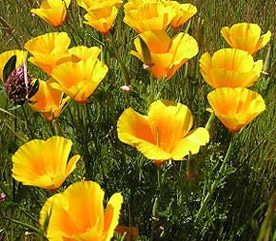Get More Bang for Your Gardening Buck
Is your weekly trip to the garden centre draining your wallet? Here are nine ways to cultivate a lush outdoor garden on a budget.

Don’t Pay Retail for Plants
Why pay top dollar to a garden center when you may be able to find plants that are every bit as healthy at other outlets? Arboretums and botanical gardens often hold plant sales, as do neighbourhood and high school gardening clubs. Though your local nursery owner won’t be happy, your purchases will go toward a good cause.
Give the Gift of Perennials
You could pay top dollar to give a potted plant to a friend for a birthday or other special occasion. Or you could keep your money and find beautiful plants in your own garden to use as gifts. Many perennials need to be divided every couple of years as they grow. Flowers that grow from bulbs, such as tulips and lilies, are the easiest to divide. After these plants flower, gently lift them from the ground, pull off the little bulbs that have formed alongside the original bulb, and replant these in potting soil. Voilà! A living gift for your best friend.
Raid Your Neighbour’s Garden
Although garden centers don’t like to talk about it, many of those pricey perennials they stock on their shelves are available for free in your neighbour’s garden. Ask if he or she has any perennials that need to be divided-offer to help with the labor in exchange for taking some home for your own garden.
Smaller Can Be Better
Nurseries and garden centers would love to sell you the biggest plant they can, since they can charge top dollar. But if you’re buying flowering perennials, choose a 1-litre container of plants over a 3.8-litre container. Young perennials tend to grow quickly, and within a single season they will catch up in size with those larger plants you could have purchased at a considerably higher cost.
Mind the Invaders
Although garden centers may try to sell you on easy-to-grow plants, some plants spread aggressively and can be very hard to get rid of once they are introduced in a garden. These include ground covers such as periwinkle; flowering plants like fleabane and other asters, broom, forget-me-nots, hollyhocks, verbena, yarrow, and daisies; and other plants such as ferns, mints, and strawberries. Most of these plants have their place in a garden, but make sure to keep them in their place by pulling up shoots wherever you don’t want them, or by planting such varieties only in defined areas such as pots, containers, beds bounded by pavement, or raised beds.
“Drought Tolerant” Doesn’t Mean “Don’t Water”
Beware of the self-appointed xeriscaping expert who says all you need to do is plant the right varieties and then throw away the hose. To get a proper start on life in your garden, drought-tolerant plants need regular watering for the first year after you plant them. After that, as long as you’ve planted varieties suitable for your zone, these plants should be able to live on the local rainfall in all but exceptional drought conditions.
Go Wild (But Not Too Wild)
Seed companies make those boxes or bags of premixed wildflower seeds seem like the answer to all your prayers. Just scatter them on the ground, add water, and a beautiful meadow full of wildflowers will magically appear. But be careful. According to Susan Aldrich-Markham of the Oregon State University extension service, those mixes may contain invasive species that are inappropriate for your area. The best way to make sure your wildflower garden is safe and appropriate for your area is to select packets of seeds for individual wildflowers, rather than mixes, so you can choose your own blend and be sure what you’re planting. If you opt for a seed mix, Aldrich-Markham recommends buying from a local company, because the more widely a mix is distributed, the more likely it is to hold inappropriate seeds for a given area. Make sure the packet lists all of the varieties of seeds it contains, and look up any plants that are unfamiliar.
Squirt Your Rosebushes
Longtime gardener Rita Carey from Squamish, British Columbia, works at a garden center, but that doesn’t stop her from recommending this homemade, environmentally friendly spray for rose pests and diseases. Here’s her recipe: In an empty 3.8-litre milk jug, mix 1 1/2 teaspoons baking soda, 1 tablespoon vegetable oil, 1/2 teaspoon liquid dish soap, and 1/2 cup white vinegar. Fill the jug the rest of the way with water and add the mixture to a sprayer. Spray all of the leaves and stems of your roses at least once a week during growing season.
Think Low-tech
For watering flower beds and other plantings, drip irrigation is the best method-it’s extremely water-efficient, and the slow, deep watering is great for plant health. But maybe you don’t need the expense of a full installed system-here’s a simple way to give plants a deep soaking with no expense at all. Save up plastic 2-litre soda bottles and 3.8-litre milk bottles. Punch a small hole in the bottom of each, then fill each container with water. Stand each bottle next to a plant, and it will slowly release the water. For trees, use 19-litre collapsible water carriers designed for camping, with their valves set on the slowest drip.



